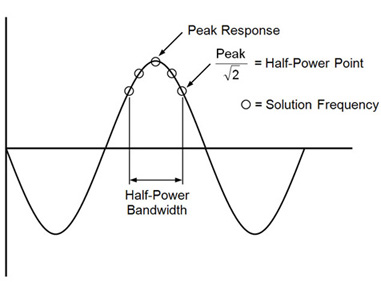Frequency List, Alternate Form 4
Description: Defines a set of frequencies used in the solution of modal frequency-response problems specifying the amount of "spread" around each natural frequency and the number of equally space excitation frequencies within the spread.
Format:

Example:

| Field | Definition | Type | Default |
|---|---|---|---|
| SID | Set identification number. | Integer > 0 | Required |
| F1 | Lower bound of frequency range in cycles per unit time. | Real ≥ 0.0 | 0.0 |
| F2 | Upper bound of frequency range in cycles per unit time. | Real > 0.0, F2 ≥ F1 | F1 |
| FSPD | Frequency spread, +/- the factional amount specified for each mode which occurs in the frequency range F1 to F2. | 0.0 < Real < 1.0 | 0.10 |
| NFM | Number of evenly spaced frequencies per spread mode. | Integer > 0 | 3 |
Remarks:
- FREQi entries must be selected with the Case Control command FREQUENCY = SID.
- There will be NFM excitation frequencies between (1 – FSPD)*fi for each natural frequency in the range F1 to F2.
- In the example above, the will be 11 equally spaced frequencies across a frequency band of 0.8*fi to 1.2*fi for each natural frequency that occurs between 10 and 1000.
- The frequency spread can be used also to define the half-power bandwidth. The half-power bandwidth is given by
 where
where
 is the damping ratio. Therefore, if FSPD is specified equal to the damping ratio for the mode, NFM specifies the number of solution frequencies within the half-power bandwidth. See Figure 1 for the definition of half-power bandwidth.
is the damping ratio. Therefore, if FSPD is specified equal to the damping ratio for the mode, NFM specifies the number of solution frequencies within the half-power bandwidth. See Figure 1 for the definition of half-power bandwidth.

Figure 1. Half-Power Point and Bandwidth
- Since the forcing frequencies are near the structural resonance, it is important that some amount of damping be specified.
- The DFREQ model parameter specifies the threshold for the elimination of duplicate frequencies. Duplicate frequencies will be ignored if

where DFREQ is defaulted to 1.0x10-5 and
 and
and
 are the maximum and minimum solution frequencies of the combined FREQi entries. (See Section 5,
Parameters, for more information on
DFREQ.)
are the maximum and minimum solution frequencies of the combined FREQi entries. (See Section 5,
Parameters, for more information on
DFREQ.)